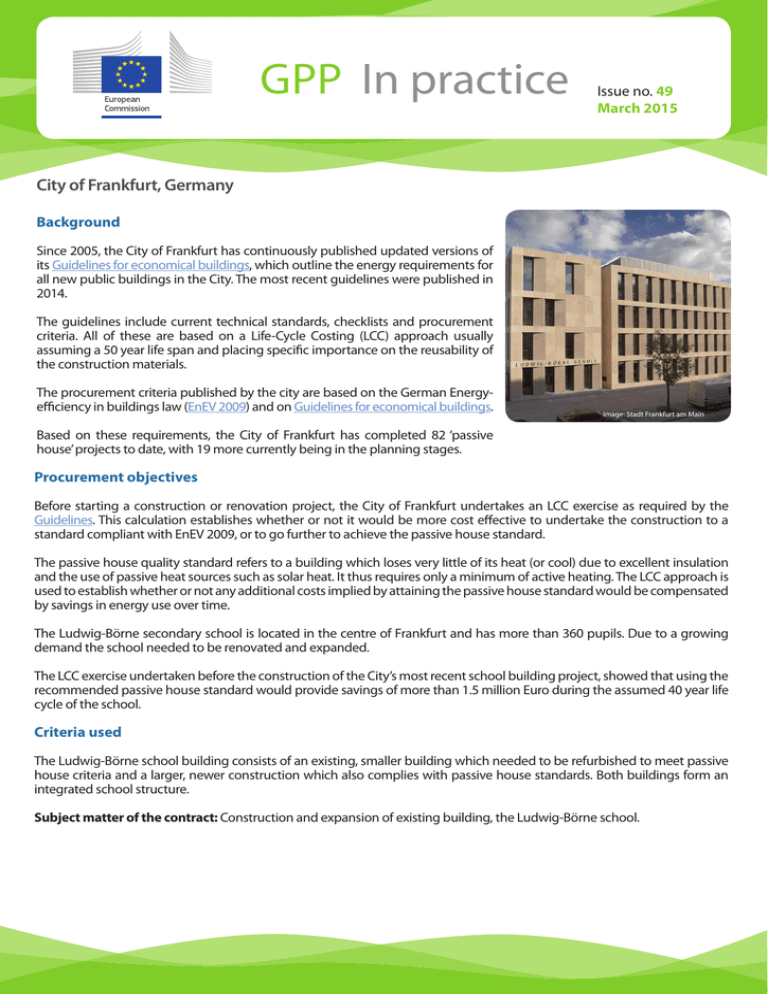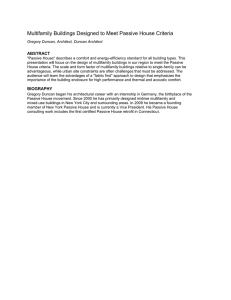Guidelines for economical buildings
advertisement

GPP In practice Issue no. 49 March 2015 City of Frankfurt, Germany Background Since 2005, the City of Frankfurt has continuously published updated versions of its Guidelines for economical buildings, which outline the energy requirements for all new public buildings in the City. The most recent guidelines were published in 2014. The guidelines include current technical standards, checklists and procurement criteria. All of these are based on a Life-Cycle Costing (LCC) approach usually assuming a 50 year life span and placing specific importance on the reusability of the construction materials. The procurement criteria published by the city are based on the German Energyefficiency in buildings law (EnEV 2009) and on Guidelines for economical buildings. Image:Frankfurt Tipperary Energy Agency Image: Stadt am Main Based on these requirements, the City of Frankfurt has completed 82 ‘passive house’ projects to date, with 19 more currently being in the planning stages. Procurement objectives Before starting a construction or renovation project, the City of Frankfurt undertakes an LCC exercise as required by the Guidelines. This calculation establishes whether or not it would be more cost effective to undertake the construction to a standard compliant with EnEV 2009, or to go further to achieve the passive house standard. The passive house quality standard refers to a building which loses very little of its heat (or cool) due to excellent insulation and the use of passive heat sources such as solar heat. It thus requires only a minimum of active heating. The LCC approach is used to establish whether or not any additional costs implied by attaining the passive house standard would be compensated by savings in energy use over time. The Ludwig-Börne secondary school is located in the centre of Frankfurt and has more than 360 pupils. Due to a growing demand the school needed to be renovated and expanded. The LCC exercise undertaken before the construction of the City’s most recent school building project, showed that using the recommended passive house standard would provide savings of more than 1.5 million Euro during the assumed 40 year life cycle of the school. Criteria used The Ludwig-Börne school building consists of an existing, smaller building which needed to be refurbished to meet passive house criteria and a larger, newer construction which also complies with passive house standards. Both buildings form an integrated school structure. Subject matter of the contract: Construction and expansion of existing building, the Ludwig-Börne school. GPP In practice The contract was awarded to the bidder offering the lowest total life cycle cost of the construction and operation of the building. This included capital costs, maintenance costs, energy demand, energy consumption, average increase of energy costs per year and CO2 emissions. The passive house standard reduces the average CO2-Emissions from 27 kg/m²a originally to just 16 kg/m²a. For this building of 5,277 m² the CO2reduction is 58 tons per year or 2,900 tons in the whole life-cycle of 40 years. Issue no. 49 I March 2015 Compared to 1990 values the passive house strategy for public buildings saved the City of Frankfurt -5% in electricity, -14% gas and -95% in heating oil consumption, demonstrating that the requirement for passive house buildings in most public construction projects has a direct, positive impact on the City’s budget and contributes to climate change mitigation. Technical specifications The technical specifications are defined in the Guidelines for economical buildings which were attached to the tender. The entire building was required to be constructed (and refurbished) to the following standards: Energy efficiency: • Required average energy consumption for both building sections: - Heating energy demand: 19 kWh/m²a - Electricity demand: 18 kWh/m²a - Primary energy demand: 61 kWh/m²a - CO2 emissions: 16 kg/m²a • Thermal bridges have to be minimised so that their addition to the u-values is no more than 0.05W/m²K. • External doors must be fitted with automatic closing mechanisms (closing time ≤ 5 s). Children have to be able to open these doors on their own. • All surfaces potentially usable for solar energy generation have to be made viable for a later fitting with solar or photovoltaic panels. Interior climate: • To avoid overheating in summertime a storage mass of at least 100Wh/m²K is to be provided for each room (e.g. avoidance of suspended ceilings, integration of heavy internal walls, use of cement screed). • An effective external solar protection which even at full protection has to able to function without artificial lighting (blinds which can be tilted both ways and allow for good ventilation, reduction factor according to DIN 4108-2 or equivalent Fc <= 0.25). Construction materials: • Bituminous coatings and glues with the Gis code BBP 40-70 may not be used, these include harmful substances, solvents and aromatic compounds. • Epoxy resin products with the Gis code RE 4-9 may not be used, which include those containing solvents, carcinogenic substances and sensitising agents . • Construction parts must be durable, recyclable and easy to disassemble (screws instead of nails and glue). Construction: • Pollutants on the construction site may not come in contact with the ground. • Construction machinery has to comply with the current emission thresholds for machinery and appliances as listed at www.uba.de. Award criteria: • Variant solutions are allowed • The contract was awarded to the bidder offering the lowest total life cycle cost of the construction and operation of the building. This included capital costs, maintenance costs, energy demand, energy consumption, average increase of energy costs per year and CO2 emissions. GPP In practice Issue no. 49 I March 2015 Contract performance clauses: The contract was monitored using the checklists provided in Guidelines for economic buildings. If actual consumption values are more than 10% above the specified requirements, the consortium of architects has to justify this. Should it turn out that the higher consumption is based on a mistake on the side of the supplier, they can be penalised financially. Results In its first year the Ludwig-Börne school consumed 41 kWh/m²a of energy for heating and 27 kWh/m²a of energy for electricity. These values are much higher than the predicted values in the LCC due to the fact that the consumption of the old gym is included in these figures and there are no separate meters for the school and the gym. The overall up front construction costs of the passive house option were 13.3 million euro, which was around 0.5 million euro higher than a standard building complying with EnEV. However, the passive house standard is expected to save costs of more than 1.5 million euro overall due to the higher energy efficiency of the building. The school will therefore save a total of around 1 million euros over its life cycle. The results of a number of Frankfurt’s passive house projects have been documented in German. Environmental impacts Between 40-50% of globally utilised raw materials are transformed annually into materials and products which are used in the construction industry. Buildings account for a major share of energy consumption and greenhouse gas emissions in the European Union, while 40% of the total amount of waste generated in Europe annually derives from construction and demolition prior to recovery. Most of this waste can be recycled or re-used. Construction work can also have significant impacts on local water reserves due to high wastewater generation during construction. The passive house standard reduces the average CO2-Emissions from 27 kg/m²a originally to just 16 kg/m²a. For this building of 5,277 m² the CO2-reduction is 58 tons per year or 2,900 tons in the whole life-cycle of 40 years. Lessons learned Compared to 1990 values the passive house strategy for public buildings saved the City of Frankfurt -5% in electricity, -14% gas and -95% in heating oil consumption. This shows that the requirement for passive house buildings in most public construction projects has a direct, positive impact on the City’s budget and contributes to climate change mitigation and effective use of natural resources. So far the City of Frankfurt has not been able to monitor the overall electricity and HVAC consumption in all of their passive house buildings due to the fact that no separate meters were installed on large building sites or in houses constructed and rented out to private organisations (such as private kindergartens). In the future the City will aim to install separate meters in all houses and sign agreements with private tenants to ensure that they are able to monitor their consumption also. Some passive houses didn’t perform as planned as a result of improper maintenance and improper usage. To avoid such failures in the future, the City wishes to increase the staff responsible for the continuous quality management in the buildings. The City did use timber pellet heating for one of the buildings but realised that due to the stand-by consumption, it is not efficient and has significantly higher consumption rates than other types of heating. In future alternatives to pellet heating will be sought. Contact: Mathias Linder, Energy Management, Office of Public Works, City of Frankfurt am Main, Germany. mathias.linder@stadt-frankfurt.de

